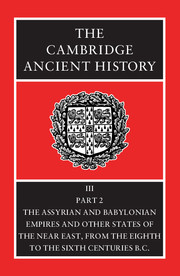Book contents
- Frontmatter
- Contents
- List of maps
- List of text-figures
- Preface
- PART I ASSYRIA AND BABYLONIA
- PART II THE EASTERN MEDITERRANEAN AND THE BLACK SEA
- 29 Israel and Judah from the coming of Assyrian domination until the fall of Samaria, and the struggle for independence in Judah (c. 750–700 B.C.)
- 30 Judah until the fall of Jerusalem (c. 700–586 B.C.)
- 31 The Babylonian Exile and the restoration of the Jews in Palestine (586–c. 500 B.C.)
- 32 Phoenicia and Phoenician colonization
- 33 Scythia and Thrace
- 34 Anatolia
- 35 Egypt: the Twenty-fifth and Twenty-sixth Dynasties
- Chronological Table
- Note on The Calendar
- BIBLIOGRAPHY
- Index
- Map 11: Phoenician and Punic sites in Spain
- Map 13: Scythia
- Map 14: Thrace
- References
29 - Israel and Judah from the coming of Assyrian domination until the fall of Samaria, and the struggle for independence in Judah (c. 750–700 B.C.)
from PART II - THE EASTERN MEDITERRANEAN AND THE BLACK SEA
Published online by Cambridge University Press: 28 March 2008
- Frontmatter
- Contents
- List of maps
- List of text-figures
- Preface
- PART I ASSYRIA AND BABYLONIA
- PART II THE EASTERN MEDITERRANEAN AND THE BLACK SEA
- 29 Israel and Judah from the coming of Assyrian domination until the fall of Samaria, and the struggle for independence in Judah (c. 750–700 B.C.)
- 30 Judah until the fall of Jerusalem (c. 700–586 B.C.)
- 31 The Babylonian Exile and the restoration of the Jews in Palestine (586–c. 500 B.C.)
- 32 Phoenicia and Phoenician colonization
- 33 Scythia and Thrace
- 34 Anatolia
- 35 Egypt: the Twenty-fifth and Twenty-sixth Dynasties
- Chronological Table
- Note on The Calendar
- BIBLIOGRAPHY
- Index
- Map 11: Phoenician and Punic sites in Spain
- Map 13: Scythia
- Map 14: Thrace
- References
Summary
TIGLATH-PILESER III AND THE ASSYRIAN THREAT
In the first half of the eighth century B.C. the independent kingdoms of Israel and Judah enjoyed a period of prosperity which had not been known since the time of Solomon in the tenth century. A new situation began to develop, however, with the accession of Tiglath-pileser III to the throne of Assyria in 744 B.C. At that time Uzziah (767–740) was still in power in Judah, while Menahem (752–742), the founder of the fifth dynasty of Israelite kings since the death of Solomon, was ruling in Samaria. Very little is said about Menahem in the Old Testament. He seems to have been violent and ruthless (II Ki. 15:16); when there was a threat from the power of Assyria he was quick to collect treasure from the wealthy men of Israel in order to pay substantial tribute in silver (II Ki. 15:19–20). This passage names ‘Pul, King of Assyria’ as the recipient of the tribute, Pul being another name for Tiglath-pileser III, as stated in I Chron. 5 : 26, and indeed in his annals the latter boasts that he received tribute from ‘Menahem the Samarian’. The date at which Menahem paid this tribute is uncertain.
During the eighteen years of his reign Tiglath-pileser established the power of Assyria in the west, but while his own inscriptions supply a considerable amount of information about his conquests, they have been preserved in such a form as to make it very difficult to assign the military activities narrated in them to exact years in his reign.
- Type
- Chapter
- Information
- The Cambridge Ancient History , pp. 322 - 370Publisher: Cambridge University PressPrint publication year: 1992



